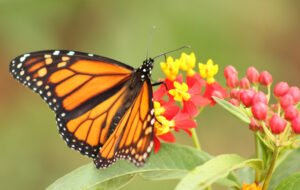By Bernheim
Source: The News Enterprise
July 5, 2018
Art can be found in many places, including nature.
As a part of Bernheim Arboretum and Research Forest’s Lunch and Learn program, adults can learn all about butterflies, how they fit into the natural world and how they add to the artistic landscape of nature. The program is for adults who want to learn more about nature and includes lunch from Isaac’s Cafe at Bernheim. Corinne Mastey, a butterfly expert and naturalist, will lead The Art of Butterflying.
“Corinne has been sharing her love of wildflowers and pollinators with Bernheim and Bernheim’s visitors for about 15 years,” said Wren Smith, interpretive programs manager at Bernheim. “It is just a delight to watch how she helps open our visitors’ eyes to not just butterflies but caterpillars and the plants that play an essential role.”
She doesn’t call herself an expert, just someone who has a genuine interest. July, she said, is the beginning of butterfly season.
The program spends time in three different locations near the visitor’s center. There is a variety of nectar and host plants in the prairie area and edible garden and an area of bottle brush near the main parking lot that draws many butterflies, Mastey said. When teaching about butterflies in the past, she used to catch them in a net, but because of the depleting populations of Kentucky butterflies, she now provides binoculars to participants and helps them use their phones to observe butterflies.
“I want them to develop an appreciation about certain things as we stand there and watch the butterflies,” she said, adding participants have time to observe the butterflies because they are not in a hurry after they land and drink nectar.
Mastey said this gives observers opportunities to study different butterfly characteristics.
• There are three main sizes of butterflies, she said. Large is 3 to 4 inches from wingtip to wingtip; medium is 2 to 3 inches; and small is about the size of a fingernail.
• Notice its shape. Does it have tails? Most people, Mastey said, can recognize a swallowtail but might not know what kind because five or six different species exist.
• Color
• Design characteristics such as crescents and eye spots on the wings or striping and along with that the parts of the butterfly like checkered antenna.
“We’re going to look at the tiny little details that will identify what it is as we observe it,” Mastey said.
The flight pattern, if a butterfly flaps it’s wings or glides, is another characteristic to observe, she said.
Butterflies are divided into five main categories: swallowtail, brush-footed, skippers, whites and sulphurs and gossamer-winged, Mastey said.
“The art of butterfly observation is learning how to enhance your appreciation of these little beauties,” she said.
As a naturalist, she’s learned three questions to ask when looking at butterflies.
To distinguish between a moth and a butterfly, she will ask, “What is it?” In Kentucky, 150 species of butterflies and about 2,000 species of moths exist, she said.
Next, she will ask, “What does it do?” The butterfly lands on a flower to consume nectar and becomes a pollinator, she said. It drinks liquid nectar and goes from tubular flower to flower. As it does that, it picks up pollen as it flaps its wings and flies to the next flower, she said.
This also helps answer her third question, “How does it do what it does?”
“If we can answer those three questions, it helps us in our observation,” she said.
Mastey is hoping participants will be able to see a butterfly egg during their observation.
She wants people to know butterflies are remarkable survivors, resilient and strong. They are great pollinators, second only to bees and the numbers are declining significantly, Mastey said.
A lot of the decline is because of climate change, she said. But people can help by not using roundup on pollinating flowers and creating prairie habitats. Planting nectar and host plants for the caterpillar also will help, she said.
As far as the art aspect of butterflies, Mastey said one of Bernheim Forest’s main principles is to incorporate nature and art.
She said each of the 150 species is different in the diversity of colors, shapes, behaviors and courtship. She pointed to a poem by Robert Frost that said of butterflies, “These are flowers that fly and all but sing.”
“That’s what art is, all the great artists look for that,” she said, adding they want uniqueness in their art.
For Mastey, there’s nothing more beautiful than the natural colors of a butterfly.
“It’s hard to draw your own butterfly design as beautifully as nature,” she said.
She said the act of metamorphosis that a butterfly goes through is art in itself. She called it “mystery and magic” that serves as a metaphor for life.
“If you think about it, our lives are like the caterpillar and butterfly,” Mastey said, adding they have struggles, determination and have to survive to make the most of their lives.
“They are about the most beautiful of all insects,” she said.
Lunch and Learn: The Art of Butterflying is from 10:30 a.m. to 1 p.m. Wednesday at the Bernheim Forest visitor center. Registration and payment are due by 4 p.m. Tuesday. The cost is $15 for members and $20 for others. For information or to register, call 502-955-85122.


